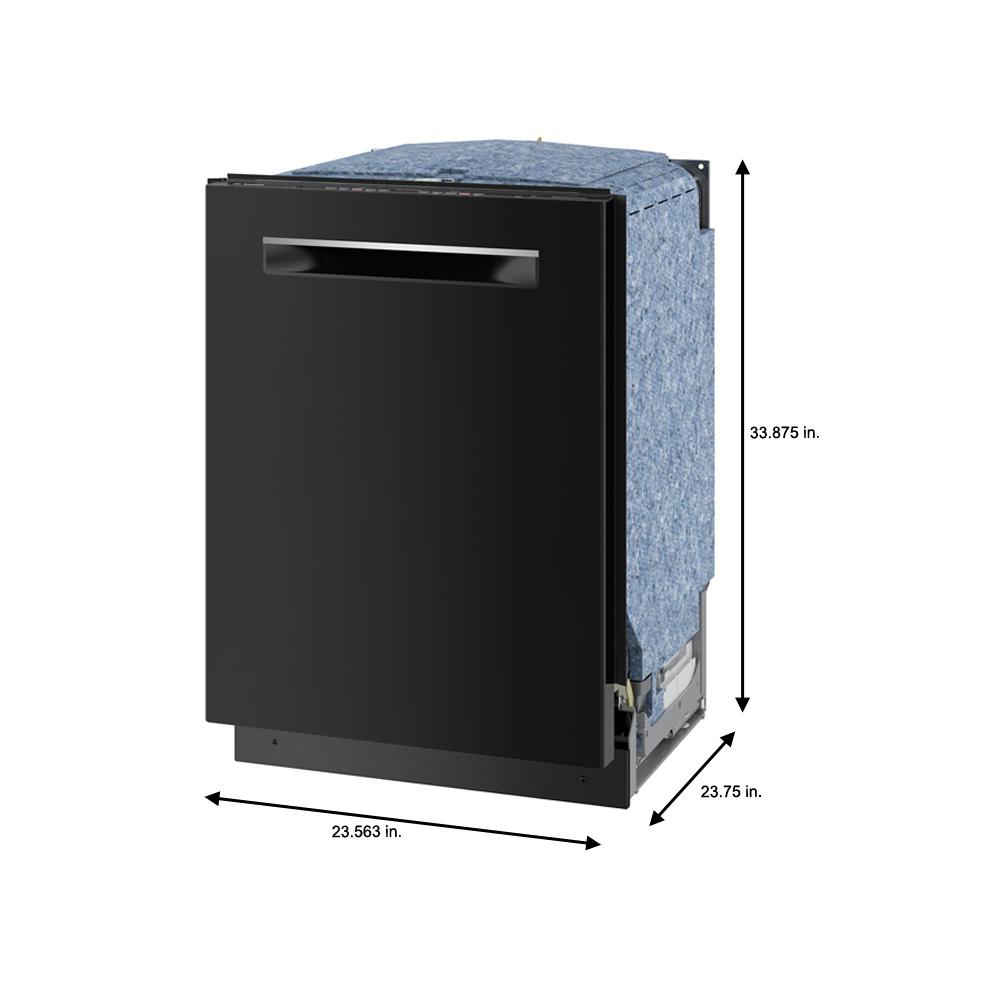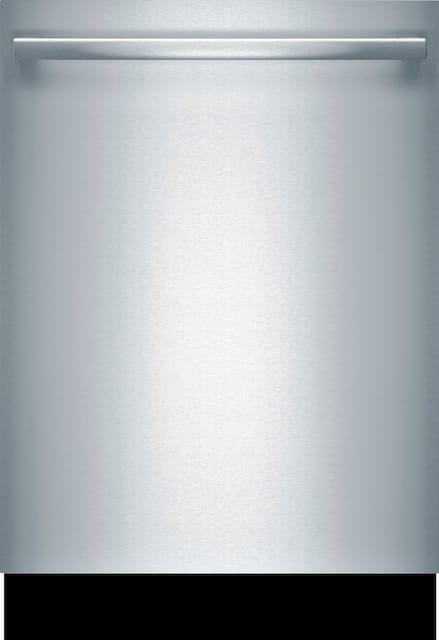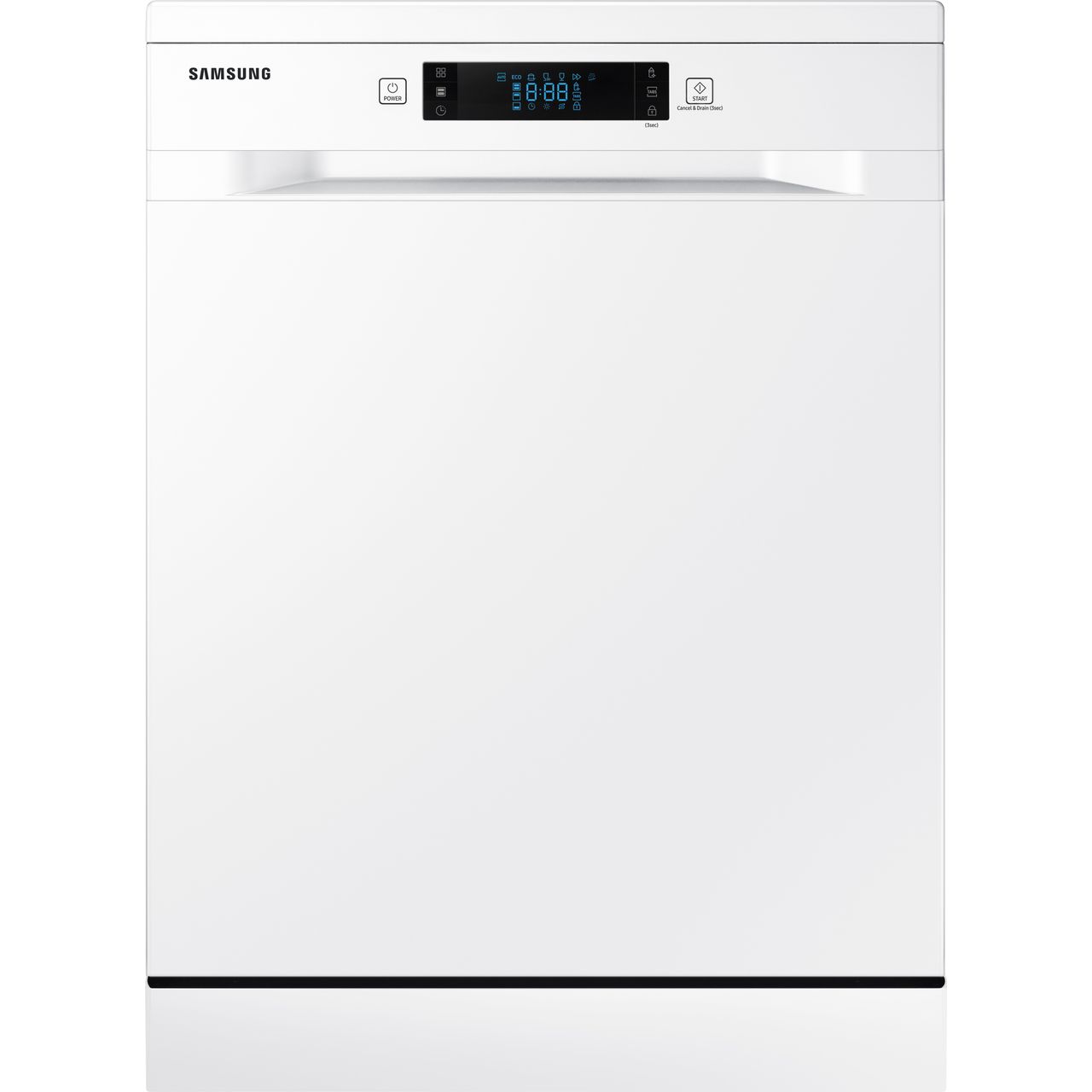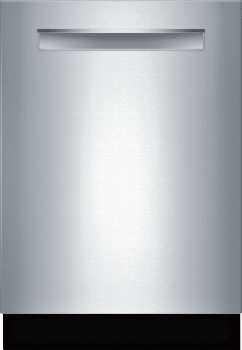Samsung 24 in. Fingerprint Resistant Stainless Steel Top Control Built-In Tall Tub Dishwasher with AutoRelease Dry and 48 dBA
Powerful jets for tough to reach spots. Quiet wash cycles. 48 dBA sound level.
The Samsung Built-In Dishwasher with Heavy duty StormWash system has powerful rotating spray jets that clean at every angle for tough to reach spots.Take advantage of silent washes for a quieter kitchen at 48 dBA sound level. The AutoRelease door automaticallyopen to circulate air and improve drying performance, while the third rack provides additional loading capacity.
- StormWash powerful rotating spray jets that clean at every angle for tough to reach spots
- Quiet Cleaning washes for a quieter kitchen at 48 dBA sound level
- AutoRelease Door at the end of the cycle, the door automatically opens to circulate air and improve drying performance
- 3rd rack provides extra space to load additional utensils and silverware
- Fingerprint resistant exterior helps reduce smudges for an everyday great appearance
- Easily adjustable upper rack maximizes space when you are washing tall items
- Digital Touch Control An integrated panel makes it easy to select functions with a gentle touch. Located onthe front of the door for easy access, it offers simple control and is clear and easy to read
- 6 Wash Cycles and 6 Options let you adjust the pressure and temperature
- Hidden heating element helps protect plastic, while Auto Release door improves drying performance
- Accommodate 15 place settings so that you can wash more dishes at once
- Half load option offers greater flexibility to do small loads, saving energy and water
- ENERGY STAR rated, which means lower energy bills and carbon foot print than non certified models
- ENERGY STAR rated
- Digital Leak Sensor
Additional information
| Cut-Out Depth x Height x Width (in.) | 24 x 34 x 24 |
|---|---|
| Depth - Door Shut (with Handle) (in.) | 24.5 |
| Depth - Door Shut (without Handle) (in.) | 24.5 |
| Depth With Door Open 90 Degrees (In) | 56.5 |
| Dishwasher Size (in.) | 24 |
| Height - Maximum (in) | 34.12 |
| Height - Minimum (in) | 33.87 |
| Product Depth x Height x Width (in.) | 24.75 x 33.875 x 23.875 |
| Certifications and Listings | Energy Star,NSF Certified,UL Listed |
| Manufacturer Warranty | One (1) Year All Parts and Labor Five (5) Year Limited on Printed Circuit Board and Interior Nylon Racks Lifetime Limited Warranty on Stainless Steel Door Liner and Tub for Leakage |
24 may refer to:
- 24 (number), the natural number following 23 and preceding 25
- one of the years 24 BC, AD 24, 1924, 2024
48 may refer to:
- 48 (number)
- one of the years 48 BC, AD 48, 1948, 2048
- '48 (novel)
- '48 (magazine)
- "48", a song by Tyler, the Creator from the album Wolf
- 48, a phone network brand of Three Ireland
- "Forty Eight", a song by Karma to Burn from the album V, 2011
- 48 Doris, a main-belt asteroid
- Tucker 48, a sedan
Built may refer to:
- Built (TV series), an American reality television series that aired on the Style Network
- Built: the hidden stories behind our structures, 2018 book by Roma Agrawal
- Building
A dishwasher is a machine that is used to clean dishware, cookware, and cutlery automatically. Unlike manual dishwashing, which relies on physical scrubbing to remove soiling, the mechanical dishwasher cleans by spraying hot water, typically between 45 and 75 °C (110 and 170 °F), at the dishes, with lower temperatures of water used for delicate items.
A mix of water and dishwasher detergent is pumped to one or more rotating sprayers, cleaning the dishes with the cleaning mixture. The mixture is recirculated to save water and energy. Often there is a pre-rinse, which may or may not include detergent, and the water is then drained. This is followed by the main wash with fresh water and detergent. Once the wash is finished, the water is drained; more hot water enters the tub by means of an electromechanical solenoid valve, and the rinse cycle(s) begin. After the rinse process finishes, the water is drained again and the dishes are dried using one of several drying methods. Typically a rinse-aid, a chemical to reduce the surface tension of the water, is used to reduce water spots from hard water or other reasons.
In addition to domestic units, industrial dishwashers are available for use in commercial establishments such as hotels and restaurants, where many dishes must be cleaned. Washing is conducted with temperatures of 65–71 °C (149–160 °F) and sanitation is achieved by either the use of a booster heater that will provide an 82 °C (180 °F) "final rinse" temperature or through the use of a chemical sanitizer.
Dry or dryness most often refers to:
- Lack of rainfall, which may refer to
- Arid regions
- Drought
- Dry or dry area, relating to legal prohibition of selling, serving, or imbibing alcoholic beverages
- Dry humor, deadpan
- Dryness (medical)
- Dryness (taste), the lack of sugar in a drink, especially an alcoholic one
- Dry direct sound without reverberation
Dry or DRY may also refer to:
A fingerprint is an impression left by the friction ridges of a human finger. The recovery of partial fingerprints from a crime scene is an important method of forensic science. Moisture and grease on a finger result in fingerprints on surfaces such as glass or metal. Deliberate impressions of entire fingerprints can be obtained by ink or other substances transferred from the peaks of friction ridges on the skin to a smooth surface such as paper. Fingerprint records normally contain impressions from the pad on the last joint of fingers and thumbs, though fingerprint cards also typically record portions of lower joint areas of the fingers.
Human fingerprints are detailed, unique, difficult to alter, and durable over the life of an individual, making them suitable as long-term markers of human identity. They may be employed by police or other authorities to identify individuals who wish to conceal their identity, or to identify people who are incapacitated or deceased and thus unable to identify themselves, as in the aftermath of a natural disaster.
Their use as evidence has been challenged by academics, judges and the media. There are no uniform standards for point-counting methods, and academics have argued that the error rate in matching fingerprints has not been adequately studied and that fingerprint evidence has no secure statistical foundation. Research has been conducted into whether experts can objectively focus on feature information in fingerprints without being misled by extraneous information, such as context.
Samsung Group (Korean: 삼성; Hanja: 三星; RR: samseong [samsʌŋ]; stylised as SΛMSUNG) is a South Korean multinational manufacturing conglomerate headquartered in Samsung Digital City, Suwon, South Korea. It comprises numerous affiliated businesses, most of them united under the Samsung brand, and is the largest South Korean chaebol (business conglomerate). As of 2024, Samsung has the world's fifth-highest brand value.
Samsung was founded by Lee Byung-chul in 1938 as a trading company. Over the next three decades, the group diversified into areas including food processing, textiles, insurance, securities, and retail. Samsung entered the electronics industry in the late 1960s and the construction and shipbuilding industries in the mid-1970s; these areas would drive its subsequent growth. Following Lee's death in 1987, Samsung was separated into five business groups – Samsung Group, Shinsegae Group, CJ Group, Hansol Group, and JoongAng Group.
Samsung industrial affiliates include Samsung Electronics, Samsung Heavy Industries, Samsung Engineering and Samsung C&T Corporation. Other subsidiaries include Samsung Life Insurance and Cheil Worldwide. Notable Samsung industrial affiliates include Samsung Electronics (the world's largest information technology company, consumer electronics maker and chipmaker measured by 2017 revenues), Samsung Heavy Industries (the world's second largest shipbuilder measured by 2010 revenues), and Samsung Engineering and Samsung C&T Corporation (respectively the world's 13th and 36th largest construction companies). Other notable subsidiaries include Samsung Life Insurance (the world's 14th largest life insurance company), Samsung Everland (operator of Everland Resort, the oldest theme park in South Korea) and Cheil Worldwide (the world's 15th largest advertising agency, as measured by 2012 revenues).
Stainless may refer to:
- Cleanliness, or the quality of being clean
- Stainless steel, a corrosion-resistant metal alloy
- Stainless Games, a British video game developer
- Stainless Broadcasting Company, a TV broadcaster based in Michigan, US
- Stainless Banner, the second national flag of the Confederate States of America
Steel is an alloy of iron and carbon with improved strength and fracture resistance compared to other forms of iron. Because of its high tensile strength and low cost, steel is one of the most commonly manufactured materials in the world. Steel is used in buildings, as concrete reinforcing rods, in bridges, infrastructure, tools, ships, trains, cars, bicycles, machines, electrical appliances, furniture, and weapons.
Iron is always the main element in steel, but many other elements may be present or added. Stainless steels, which are resistant to corrosion and oxidation, typically need an additional 11% chromium.
Iron is the base metal of steel. Depending on the temperature, it can take two crystalline forms (allotropic forms): body-centred cubic and face-centred cubic. The interaction of the allotropes of iron with the alloying elements, primarily carbon, gives steel and cast iron their range of unique properties. In pure iron, the crystal structure has relatively little resistance to the iron atoms slipping past one another, and so pure iron is quite ductile, or soft and easily formed. In steel, small amounts of carbon, other elements, and inclusions within the iron act as hardening agents that prevent the movement of dislocations.
The carbon in typical steel alloys may contribute up to 2.14% of its weight. Varying the amount of carbon and many other alloying elements, as well as controlling their chemical and physical makeup in the final steel (either as solute elements, or as precipitated phases), impedes the movement of the dislocations that make pure iron ductile, and thus controls and enhances its qualities. These qualities include the hardness, quenching behaviour, need for annealing, tempering behaviour, yield strength, and tensile strength of the resulting steel. The increase in steel's strength compared to pure iron is possible only by reducing iron's ductility.
Steel was produced in bloomery furnaces for thousands of years, but its large-scale, industrial use began only after more efficient production methods were devised in the 17th century, with the introduction of the blast furnace and production of crucible steel. This was followed by the Bessemer process in England in the mid-19th century, and then by the open-hearth furnace. With the invention of the Bessemer process, a new era of mass-produced steel began. Mild steel replaced wrought iron. The German states were the major steel producers in Europe in the 19th century. American steel production was centred in Pittsburgh, Bethlehem, Pennsylvania, and Cleveland until the late 20th century. Currently, world steel production is centered in China, which produced 54% of the world's steel in 2023.
Further refinements in the process, such as basic oxygen steelmaking (BOS), largely replaced earlier methods by further lowering the cost of production and increasing the quality of the final product. Today more than 1.6 billion tons of steel is produced annually. Modern steel is generally identified by various grades defined by assorted standards organizations. The modern steel industry is one of the largest manufacturing industries in the world, but also one of the most energy and greenhouse gas emission intense industries, contributing 8% of global emissions. However, steel is also very reusable: it is one of the world's most-recycled materials, with a recycling rate of over 60% globally.
Tall commonly refers to:
- Tall, a degree of height
- Tall, a degree of human height
Tall may also refer to:
Top most commonly refers to:
- Top, a basic term of orientation, distinguished from bottom, front, back, and sides
- Spinning top, a ubiquitous traditional toy
- Top (clothing), clothing designed to be worn over the torso
- Mountain top, a mountain peak located at some distance from the nearest point of higher elevation
Top may also refer to:
Tub may refer to:
- A tub (container):
- a round or oblong container with or without a lid:
- a plant pot
- a shallow, plastic or paper container, typically with a lid or closure
- Tub (unit), a former quantity for sale or butter or cheese
- a round or oblong container with or without a lid:
- A bathtub, a plumbing fixture for bathing
- Hot tub, a large bath or small pool designed to comfortably hold multiple persons
- Quarry tub, a type of railway or tramway wagon
- Slack tub, in blacksmithing, a quench
- Tub boat, an unpowered cargo boat used on early canals
- Twin tub, a type of washing machine
- Tub file, in computing, an early, primitive random access memory technology.
- Tub Welch, a baseball player.
TUB may refer to:
- TUB (gene)
- Citroën TUB, a light van
- Technische Universität Berlin (Germany)
- Transports Urbains du Beauvaisis, local public transport operator in northern France
- Tubuai – Mataura Airport (IATA airport code)
TUBS or Tubs may refer to:
- Time unit box system, a system for notating events that happen over a time period.
- Tokai University Boarding School in Denmark
- Ryan Tubridy, Irish television and radio presenter.
With or WITH may refer to:
- With, a preposition in English
- Carl Johannes With (1877–1923), Danish doctor and arachnologist
- With (character), a character in D. N. Angel
- With (novel), a novel by Donald Harrington
- With (album), a 2014 album by TVXQ
- With (EP), a 2021 EP by Nam Woo-hyun






by Grant
Works great nice and quiet as advertised.
by Collins
we spent a lot of time researching dishwashers and looking for one that would work for us. we couldn’t be happier. hand washing the containers for my pump before this was a chore. having to soak and rinse and boil them. i’m able to run a load and not worry my routine every night has become so much quicker and quieter i’m actually able to spend more time with the kids before bed because i’m not stuck at a sink worrying about getting them clean again for the next day. i didn’t even know i needed a third rack in my life for my dishwasher but won’t go without again.
by Reggie
So far, we have only used it a couple of times and with good result.
by Tony
Great product so far. Easy install too.
by Cheryl
Beautiful piece of equipment. Don’t want to use it yet because it’s so nice. It was purchased after waiting 5 months for a Whirlpool appliance. Tired of waiting and changed to Samsung. Nicer looking and cheaper!
by Roshonda
Very easy to install. Extremely quite. Love it